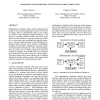Free Online Productivity Tools
i2Speak
i2Symbol
i2OCR
iTex2Img
iWeb2Print
iWeb2Shot
i2Type
iPdf2Split
iPdf2Merge
i2Bopomofo
i2Arabic
i2Style
i2Image
i2PDF
iLatex2Rtf
Sci2ools
WSC
2008
2008
Assignment of probabilities to events for combat simulation
Multitrajectory simulation allows explicit management of random events by allowing particular events to be resolved by random draw, by a deterministic choice, or by creating new states to allow following multiple trajectories. The policy for resolution method is under the control of the analyst, and may depend on event type, trajectory probability, or even some metric indicating the trajectory importance. However, taking advantage of the technique for exploring possible outcome spaces requires a probabilistic modeling of events that, in simulations of ground combat, are often treated as deterministic, such as decisionmaking. Even for events such as attrition, which have long been modeled as stochastic, how should the full event outcome set be sampled if one is only to keep two or three samples? This paper explores these issues with the goal of outlining what kinds of data would be needed to fully exploit multitrajectory methods in a combat simulation context. 1 BACKGROUND Combat is in...
| Added | 02 Oct 2010 |
| Updated | 02 Oct 2010 |
| Type | Conference |
| Year | 2008 |
| Where | WSC |
| Authors | John B. Gilmer Jr., Frederick J. Sullivan |
Comments (0)

